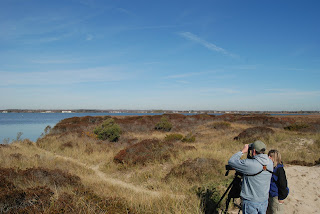Scoping Mecox Bay
Today Seth, Stella Miller, and I (Brent Bomkamp) headed out east to try to pick up some early waterfowl, and although numbers were low overall we were not disappointed.
We started the day at Hook Pond where things appeared to be relatively quiet. A few Hooded Mergansers, Gadwall, Black Ducks were on the pond, along with an American Coot, a Pied-billed Grebe, and a Belted Kingfisher. Some flocks of Canada Geese were moving overhead and I managed to pick out a Greater White-fronted Goose from one of the groups as it flew to the east. A few minutes later I spotted yet another GWFG heading in the same direction. We guessed the groups were on their way to one of the large fields along Further Lane, and we caught up with them there.
Greater White-fronted Goose-11/14/10
Seth soon picked out three more, bringing the grand total to 5. This is not unprecedented, as a similar sized group was discovered last year at the same locale, when small flocks were also seen at Belmont Lake State Park and St. John's Pond in Cold Spring Harbor. As we watched the geese a small group of American Pipits flew over the field towards the northeast.
The next stop on our trip was Sagaponack. Unfortunately the pond did not provide much in the way of birds, but there was a significant movement along the ocean. Large numbers of dark scoters were travelling in both directions, with small numbers of White-wingeds mixed in. Bonaparte's Gulls were also present in large numbers, something which we surmised due to their presence on both Hook and Sagaponack Ponds. Red-throated Loons were having a good flight, with around 75 seen.
Sagaponack Beach
Mecox Bay
Mecox proved no more birdy than Sag, aside from a small group of Dunlin sitting on a small flat that had formed there. However, while surveying the ocean side of the beach, Stella deftly located a Semipalmated Plover, a somewhat surprising bird this late in the year.
Semipalmated Plover-11/14/10
Just north of Mecox is a group of farm fields which have held many good birds in the past. In the early '90s a Northern Lapwing spent some time there, and Cattle Egrets are almost annual in the fall. Today was no exception, as at least three Cattle Egrets were loafing with the cattle at the Mecox Dairy. While viewing the egrets a pair of Horned Larks flew overhead.
Mecox Dairy, Mecox, NY
When we arrived at Short's Pond in Scuttlehole, we were struck by the sheer numbers of geese on the pond. A GWFG was here the day before, and chances were good for an unusual goose. Also present was a small group of Pintail, some coots, a Green-winged Teal, and another Belted Kingfisher. After tedious inspection, I evetually found a cooperative Cackling Goose. It remained in the open for a while, allowing all three of us excellent views, and an opportunity to examine the nuances of this bird with the larger Canadas.
Shinnecock was cold and windy, but the birds made it worthwhile to remain outside. As at Sagaponack good numbers of seabirds were offshore, with most, save for gannets, moving eastward. Our first new birds for the day were a flock of Common Eider just inside the inlet. Seth, after careful scrutiny of the hordes of Bonaparte's Gulls going by, skillfully picked out an immature Black-legged Kittiwake. Unfortunately only Stella and he were able to attain views of the bird. A small group of Boat-tailed Grackles was present by the Ponquoge Bridge.
After a delicious lunch at Orlando's in Hampton Bays, we stopped at Eastport Pond where good numbers of Aythya ducks were visible. It provided all three of us with looks at our FOS Canvasback, 17 in total. Also present were more of the expected waterfowl and a Belted Kingfisher. Just as we were getting off the Sunrise Highway, Seth noticed a pair of Cattle Egrets. This year certainly has been a banner year for the species, with at least 10 seen on Long Island, and even more throughout the northeast.
Our final stop was at Patchogue Lake for the previously reported Eurasian Wigeon. The striking male was quite easy to locate, but also surprising were the large numbers of American Coot, 141 in total.
Highlights of the Day-
Black-legged Kittiwake
5 Greater White-fronted Geese
Cackling Goose
Eurasian Wigeon
Semipalmated Plover
7 Cattle Egrets
American Pipit
Horned Lark
Horned Lark
Northern Pintail
Canvasback
Field Sparrow
Northern Harrier






No comments:
Post a Comment